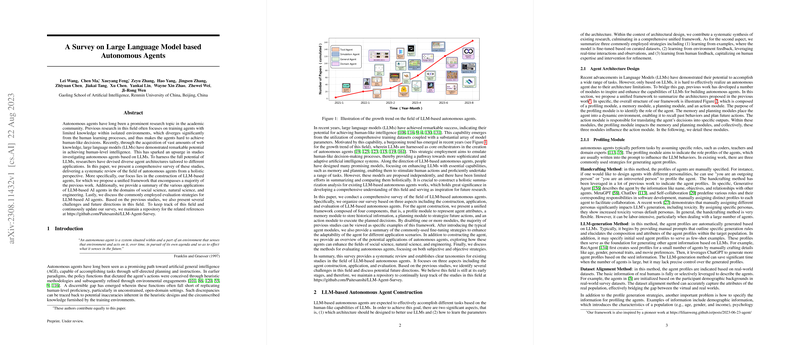A Comprehensive Survey on LLM-based Autonomous Agents
Introduction to LLM-based Autonomous Agents
Recent years have witnessed a significant surge in the integration of LLMs within the field of autonomous agents. These agents harness the extensive web knowledge encapsulated in LLMs to emulate human-level decision-making capabilities. The research focus has thus pivoted towards constructing autonomous agents with LLMs at their core, aiming for enhancement in tasks across various domains including social sciences, natural sciences, and engineering. This survey meticulously analyzes and catalogues the burgeoning field of LLM-based autonomous agents, delivering insights into their construction, applications, and evaluation methodologies.
Construction of Autonomous Agents
Architectural Design
Central to the development of LLM-based autonomous agents is their architectural framework. The quintessential architecture is composed of modules akin to human cognition, including profiling, memory, planning, and action. Each module plays a critical role; profiling identifies the agent's role, memory retains environmental interactions, planning orchestrates future actions, and the action module translates decisions into outputs. Substantial efforts have been poured into enhancing these modules for more refined agent behaviors.
Capability Enhancement
Beyond the architectural design lies the need for agents to acquire specific capabilities. Strategies span from fine-tuning on domain-specific datasets to innovations in prompt engineering and mechanism design. Each technique has its merits, with fine-tuning enabling deeper domain knowledge and prompt engineering allowing for flexible capability adjustments without altering the underlying model.
Applications Across Domains
The utility of LLM-based autonomous agents extends across multiple sectors. In social science, they simulate complex societal interactions, offering insights into psychology and political science. Natural science benefits from agents in documentation, experimental assistance, and education. In engineering, agents streamline tasks in software development, industrial automation, and robotics, showcasing their broad applicability and potential for advancing research and practical implementations.
Evaluation Strategies
Determining the effectiveness of autonomous agents is crucial, encompassing both subjective and objective methodologies. Subjective evaluation relies on human judgment, including annotations and Turing tests, to gauge agent performance. In contrast, objective evaluation employs quantifiable metrics across multiple protocols such as environment simulation and multi-task handling, supported by benchmarks like Clembench and AgentBench.
Challenges and Future Directions
Despite advancements, challenges persist within this field. Realistic role-playing, generalized human alignment, prompt robustness, hallucination mitigation, and efficiency enhancement remain open issues. Addressing these will necessitate novel approaches in LLM training, prompt design, and agent framework development.
Conclusion
LLM-based autonomous agents represent a frontier in combining AI's computational prowess with intricate models of human behavior and cognition. Their evolution paves the way for more accurate simulations, enhanced automation, and deeper insights into both artificial and natural systems. As this field matures, it promises to unlock new potentials in AI's role within society and industry, demanding continued innovation and multidisciplinary collaboration.
